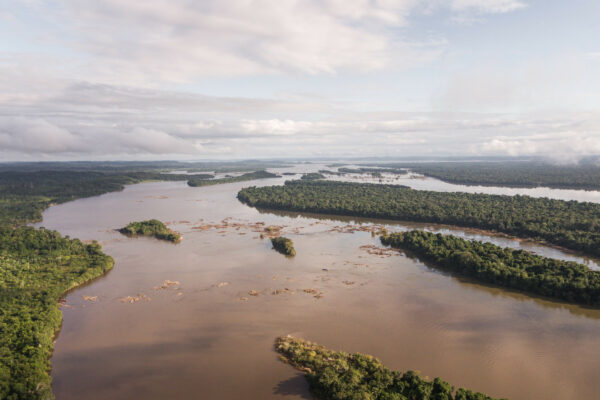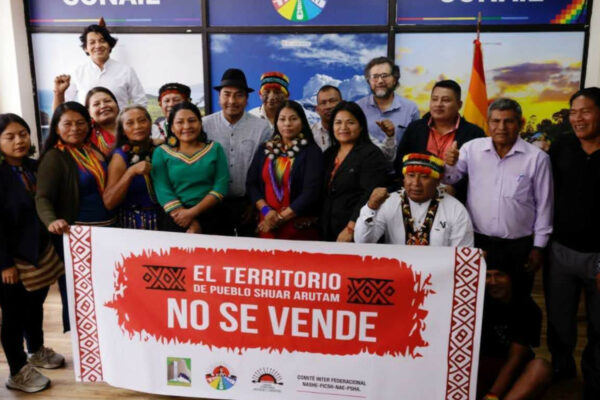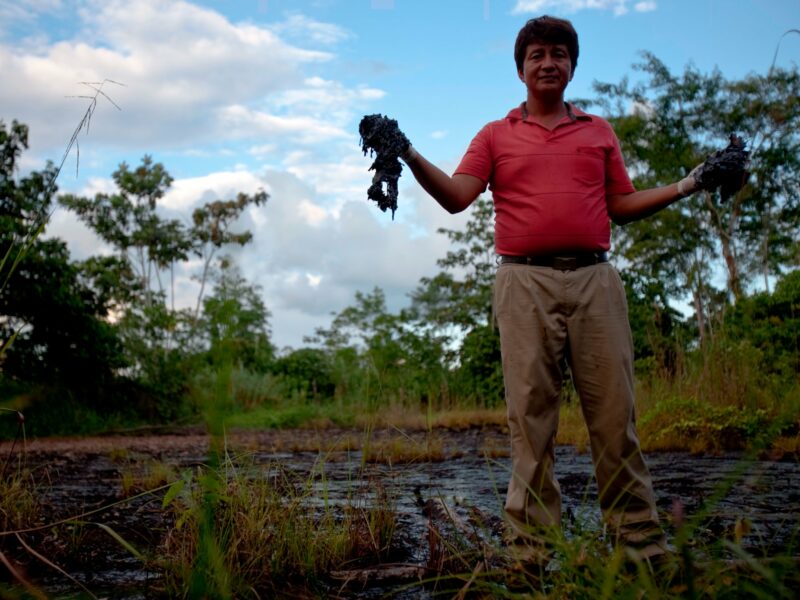ChevronTexaco investors are in for an unsettling interlude when they gather for the annual shareholders’ meeting at company headquarters in San Ramon April 27. Two indigenous Amazonian leaders, as well as numerous concerned local citizens, are set to interrupt the drab, predictable corporate discourse with testimonials about Texaco’s toxic legacy in Ecuador.
Humberto Piaguaje, who’s lost two family members to different strains of cancer, will be among them. Another relative – a nephew – recently contracted the disease, and the family lacks the money to pay for the chemotherapy he needs, Piaguaje told the Bay Guardian.
“Crude Reflections: ChevronTexaco’s Rainforest Legacy,” an exhibit of 50 photographs taken by Bay Area photographers Lou Dematteis and Kayana Szymczak and documenting what some experts say is the worst environmental devastation caused by an oil company in the history of the planet, opened at a nearby restaurant April 25 and will help reinforce the Ecuadorans’ case.
“We’ve taken delegations of investors to the region” to show them firsthand the devastation caused by Texaco’s oil development projects over the two decades ending in 1992, Amazon Watch associate director Shannon Wright told us. Now, with the photo exhibit, which will tour several cities, they’re bringing the story to the American public.
The activity surrounding ChevronTexaco’s shareholders’ meeting indicates an important maturation of the global struggle against the human and environmental devastation caused by fossil fuel development abroad.
That’s the good news.
But increasingly, oil industry analysts are pointing to an impending crisis that’s likely to result in a surge of these kinds of offenses around the globe, as oil companies vie for a dwindling supply of the black gold that fuels our economy.
The analysts refer to the phenomenon as “peak oil,” a term coined in the 1950s by M. King Hubbert, a geologist working for Shell, to indicate the point at which humans have extracted half of the earth’s oil reserves. Hubbert correctly predicted that the United States’ oil supply would peak in 1970.
“The idea of peak oil is that oil’s finite, and once you’ve reached the halfway point of a particular field, it’s progressively harder to keep your daily production [rate] the same,” Paul Roberts, Harper’s magazine contributor and author of The End of Oil: On the Edge of a Perilous New World, told us. As we reach the global peak, oil becomes harder to extract and prices begin to climb – with dire consequences for economies predicated on oil for everything from manufacturing to heating and air conditioning, transportation, and “defense.”
And as it gets harder and harder to extract oil from below the earth, companies will go to greater and greater lengths – with the potential for even further environmental disaster and human tragedy – to find those last few drops.
Not just nuts
Analysts disagree about when the world will have reached the oil peak: some say the time has already come, and others believe we’ve still got a few decades to go.
“It’s clear that the oil that was the easiest to get at is becoming harder to find,” Roberts explained. “Production rates in a lot of different countries are slowing or even flattening and declining…. Shell, for example, reported that it only found one barrel for every two that it was selling last year. And the industry in general is reporting similar numbers.”
In fact, energy policy experts have been warning about an impending energy crisis since before George W. Bush took office in 2000. Nonetheless, the term “peak oil” was largely relegated to the realm of left-wing nuts and doomsday diviners until recently. Now the phrase has begun popping up in mainstream news accounts.
San Francisco Chronicle business columnist David Lazarus referenced the peak-oil phenomenon in an April 8 article looking at ChevronTexaco’s recent $16.4 billion acquisition of Unocal.
“It’s clear that in the industry, companies have taken to acquiring smaller companies as a way to find oil because it’s easier than drilling for it,” Roberts said.
Iraq – with oil reserves rivaling, or possibly exceeding, those of Saudi Arabia – is obviously in the eye of the storm. “But even if you look at Colombia, the U.S. is indirectly getting drawn into the conflict there, by providing money and to some extent personnel to guard oil export pipelines,” Michael Renner, senior researcher at Worldwatch Institute, told us. “There are now a whole number of either permanent or temporary U.S. military bases that have come into place after 9/11 in the name of the war on terror.”
What we’re seeing, he said, is “a militarization of energy policy.”
Facing extinction
Of course, a related crisis – infinitely graver than the one felt by whiny SUV drivers at U.S. gas stations – has already walloped northern Ecuador’s Amazon region, where, advocates say, at least five indigenous groups face possible extinction thanks to millions, and possibly billions, of gallons of toxic sludge left in Texaco’s wake.
Piaguaje was born one year after Texaco (the company merged with Chevron in 2000) arrived in Ecuador in 1964. He remembers first seeing oil company workers enter his community’s ancestral lands when he was about five years old. Back then, the Secoya – the tribe to which he belongs – enjoyed a population of about 2,000 in both Ecuador and Peru, he said. About 250 remained on Ecuador’s side of the border. But that number dwindled to “less than 100” at one point, due, he said, to widespread disease and death as the result of Texaco’s pollution of local rivers and streams. The nearby Cofán dropped from 4,000 or 5,000 to a mere 700. And the Siona – also of the same region – lost almost half of their 340 members.
Local indigenous communities and subsistence farmers eventually joined forces and filed suit against Texaco in U.S. federal court in Manhattan 12 years ago. Although the court held that it lacked jurisdiction to hear the case, it nonetheless ruled that it would hold Texaco to whatever penalties an Ecuadoran court imposed on the company.
“The U.S. court decision was critical in that it forced Texaco to stipulate that it would submit to an Ecuadoran court’s ruling,” said Steven Donziger, an attorney representing the plaintiffs since they first brought their case against Texaco in 1993.
Ecuador – where just last week President Lucio Gutierrez, a staunch supporter of “free” trade and market liberalization, was forced to resign and flee the country in the face of mass protest – nets 40 percent of its export earnings and one-third of its tax revenues from oil sales, primarily to the United States.
In May 2003, it became the first Latin American country to try a foreign oil company in its courts: more than 30,000 residents of Ecuador’s rainforest filed suit against ChevronTexaco for dumping what they say amounts to 30 times the amount of crude oil spilled during the Exxon Valdez disaster. Inspections continue at 122 sites. One study, conducted at the town of San Carlos, found cancer rates 30 times the norm. Another uncovered spontaneous abortion rates 50 percent higher than normal and child mortality rates three times higher than the national average.
“Some soil samples show levels of carcinogens at more than 1,000 times higher than the maximum levels permitted by Ecuadorian law, which is permissive to corporations compared to U.S. law,” Donziger reported.
Judith Kimerling, an environmental attorney working with a federation of local indigenous communities in 1991, wrote that Texaco’s operations resulted in the burning of more than 235 billion cubic feet of natural gas, the dumping of 19 billion gallons of toxic waste, and the deforestation of 1 million hectares of rainforest.
Advocates for Ecuador’s Amazonians refer to the catastrophe as “ChevronTexaco’s rainforest Chernobyl.”
And the devastation continues. “When Texaco left in 1992, it left behind an antiquated pumping system that routinely dumps toxic waste water,” Amazon Watch’s Wright explained. The lawsuit seeks damages for all the harm that’s resulted from the faulty system – not just the mess left behind when Texaco ended its operations.
Some shareholders have accused Chevron of disclosing only the projected profitability of its acquisitions, and not the associated liabilities, as a result of activists’ efforts, Wright said. And now, with ChevronTexaco’s recent acquisition of Unocal, investors have inherited yet another hefty price tag: several lawsuits alleging the company tacitly sanctioned human rights abuses by the Burmese military – including subjecting villagers to slave labor, murder, rape, torture, and forced relocation – during the construction of the Yadana gas pipeline were settled out of court in March. The settlement terms are confidential, but they amount to enough to compensate villagers and “develop programs to improve living conditions, health care, and education, and protect the rights of people from the pipeline region,” according to the Center for Constitutional Rights, which represented the plaintiffs.
Meanwhile, this will be Piaguaje’s sixth visit to the United States to talk about Texaco’s impact in Ecuador, and the second time in two years that delegates from his region of the Amazon address ChevronTexaco investors at the company’s annual shareholders meeting.
He traveled by foot, canoe, car, and plane to get here. He’s seen San Ramon’s beautiful greenery, it’s orderliness – and everyone driving cars.
Texaco “never even acknowledged us as human beings,” he told us. “There’s been no help…. They went [to the Amazon] to extract its riches and left only suffering for us. For us to be counted as human beings is what I hope to get out of coming here.
“Something has to change. Because otherwise, we’re finished.”
‘Crude Reflections’ is on display through Thurs/28. 11 a.m.-9 p.m., Mudd’s Restaurant, 10 Boardwalk, San Ramon. Free. (925) 837-9387.
E-mail Camille T. Taiara at camille@sfbg.com.
http://www.sfbg.com/39/30/news_chevrontexaco.html













